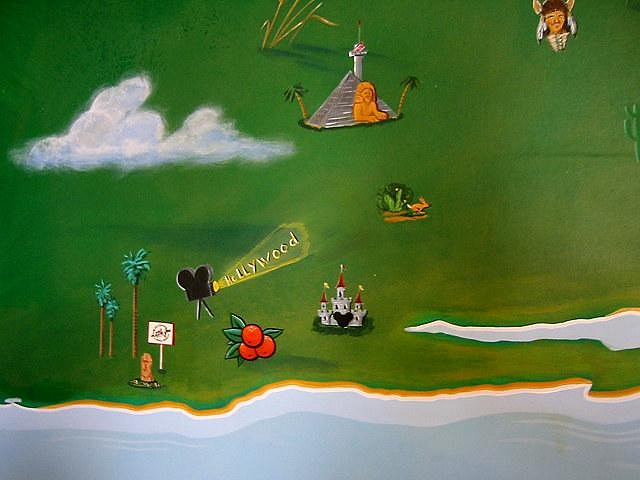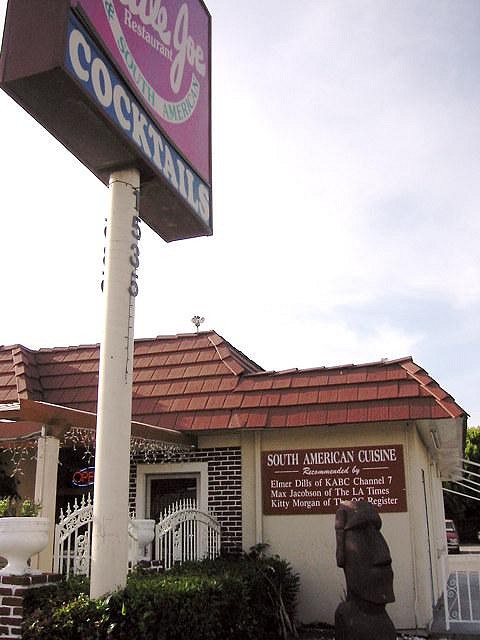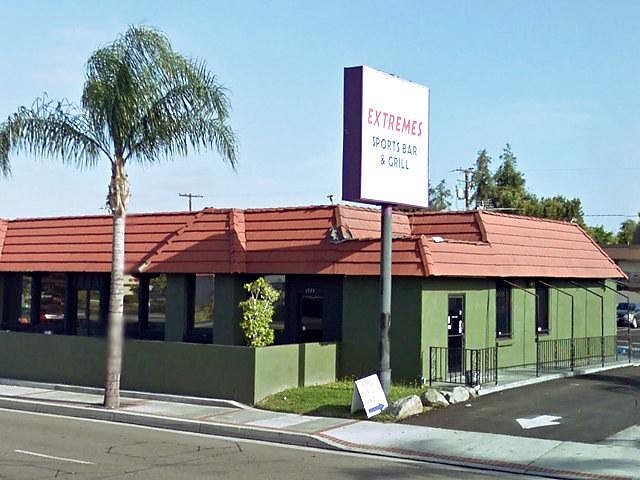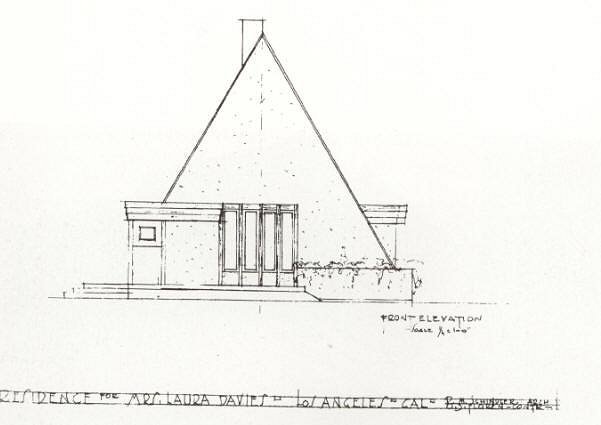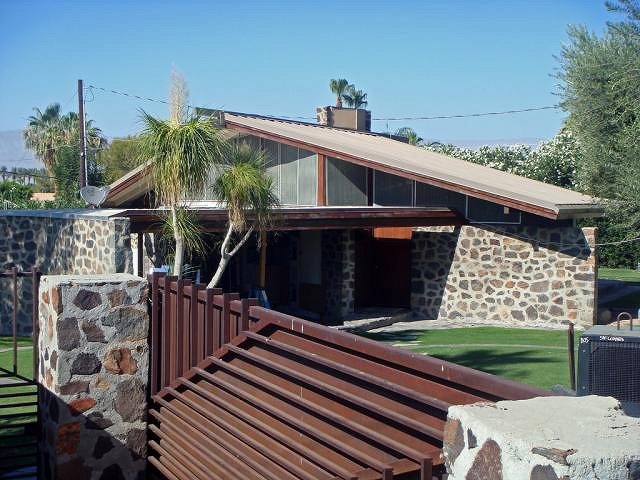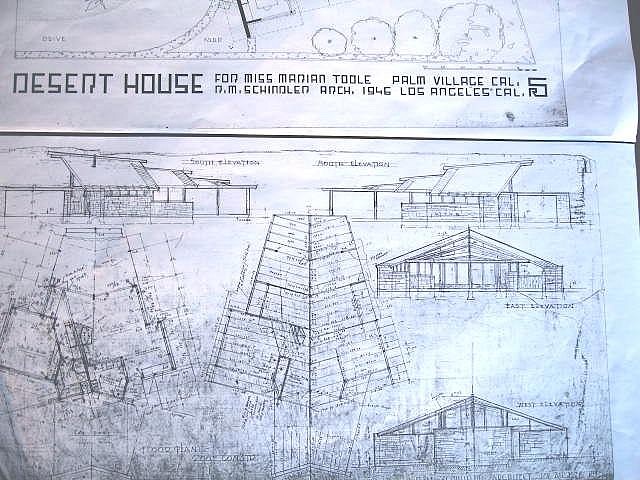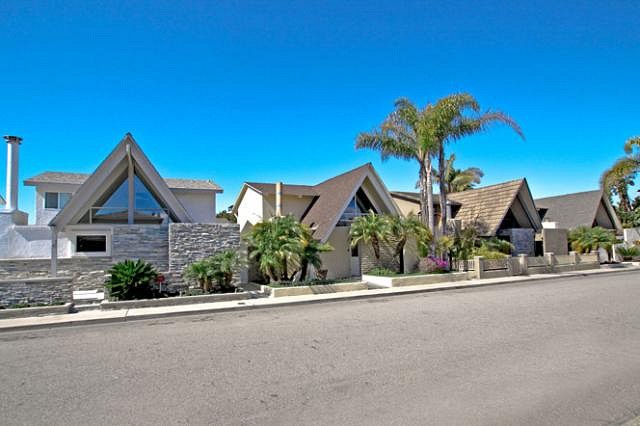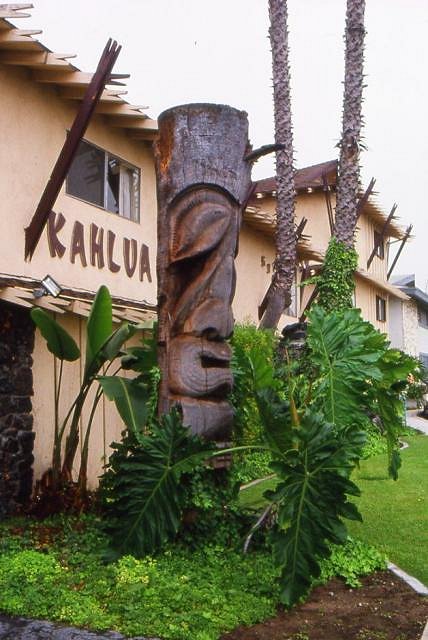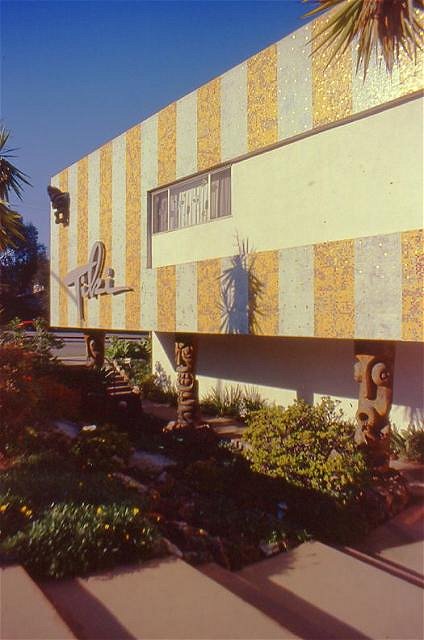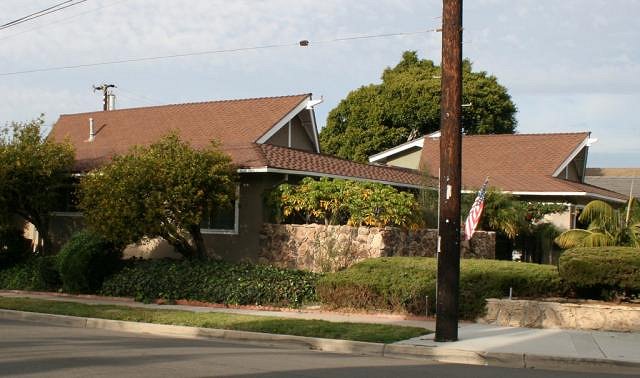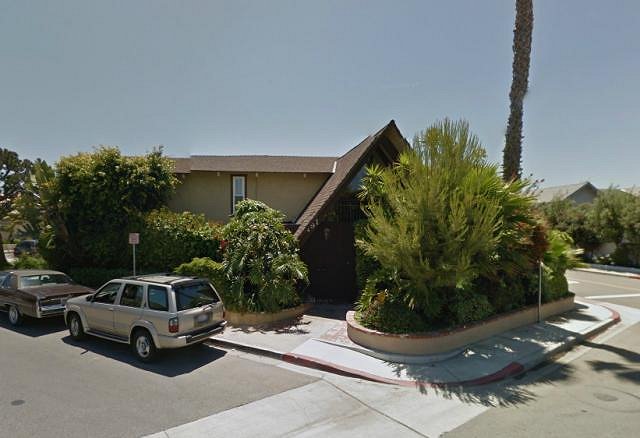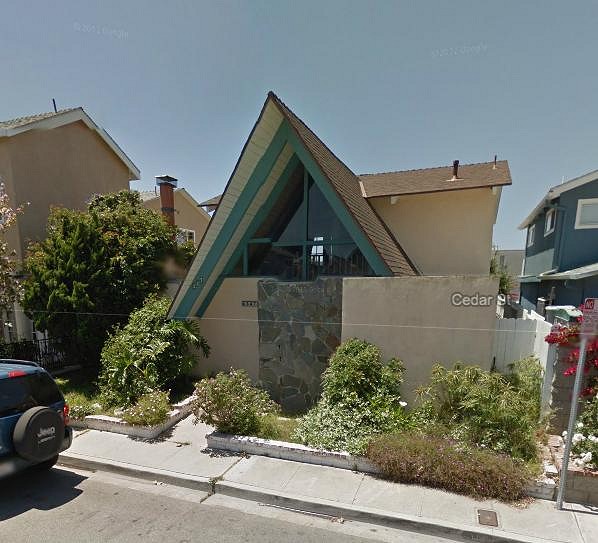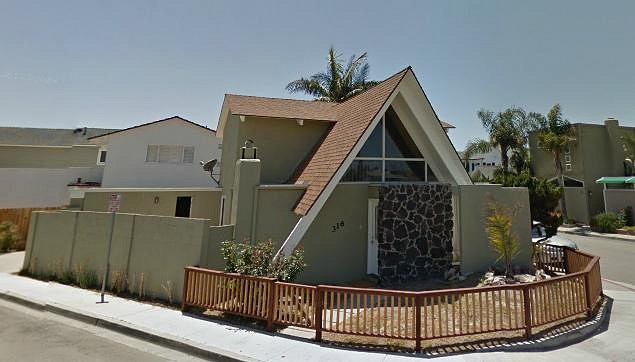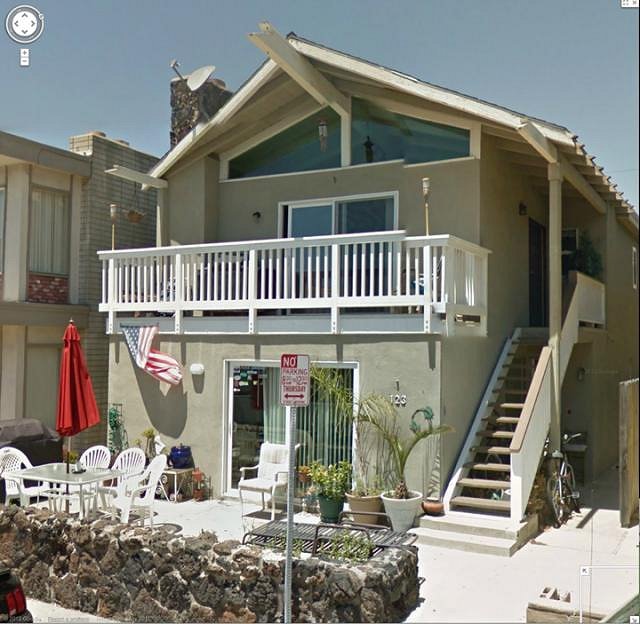Tiki Central / General Tiki
Mapping out tiki in Orange County, Calif.
|
S
SpaceAgeCity
Posted
posted
on
Sun, Jun 17, 2012 11:21 PM
I've started a collaborative mapping project on Google Maps to identify all the places in Orange County where you can still see a bit of classic tiki. Pinpointing places like Sam's/Don's was the easy part. But I'm also trying to identify the housing tracts that featured tiki/Hawaiian designs as part of their mix. See,... Your help is certainly welcomed -- Just jump in and stick pins in neighborhoods where you know tiki-style tract houses or apartments can still be seen. And before you ask: No, I'm not trying to locate all the spots where tiki once stood but has since been demolished. You won't find Christian's Hut on this map, for instance. But you will find tiki apartment complexes where the theme has been compromised but is still identifiable. Anyway, check out the map if you want to. Contribute more sites if you want to. Or maybe just drive around and check out the locations nearest you. I think this should serve as a useful resource in the future. Aloha! Chris |
|
ATP

Atomic Tiki Punk
Posted
posted
on
Mon, Jun 18, 2012 3:43 AM
I am truly sorry to critique your project Chris, But I have to point out a major flaw in many These houses have very little crawl space/ventilation areas, A raised section was necessary for proper airflow This is a common architectural trait of the tract housing from the 50s & 60s in this area One just has an Asian style roof-line, I am a student of mid century architecture in this area, Even worked as a Roofer for a few years So to serve accuracy & keep 100s or more of these (Non Tiki) style of houses from deterring from your worthy project |
|
S
SpaceAgeCity
Posted
posted
on
Mon, Jun 18, 2012 12:15 PM
Actually, each of the tracts I listed does have at least some Polynesian/Tiki/Hawaiian traits in at least some of its various models. I'm not just talking about a crawlspace. I'm talking about details and styling that aren't necessary for airflow but which hearken back to features in traditional Hawaiian or South Seas structures. You may not have FOUND those houses in these tracts yet -- or you may have overlooked ones where the styling is rather subdued -- but (barring a few errors) they're actually there. (Don't rely on the "pins" on the map to guide you. Often, I just threw a pin randomly somewhere in the tract.) In some cases, I've even found newspaper ads promoting these "Hawaiian" themes in these tracts. I appreciate your attempts to help, but I'm afraid you're wrong about this. Chris |
|
ATP

Atomic Tiki Punk
Posted
posted
on
Mon, Jun 18, 2012 1:20 PM
Well from the photos pinned at your Google site, Nope. Though your on the mark with the Apartment complexes, but many of the homes listed But maybe you can post some examples here and I will gladly eat crow. |
|
TM
tiki mick
Posted
posted
on
Mon, Jun 18, 2012 4:11 PM
I have also thought about doing something similar, mostly with the old vintage motels up and down BrookHurst and Beach streets in Anaheim. Lot's of good stuff there! But alas, I am too lazy. So, you, please. And right off the top of my head, check out what is on Ball Rd and Loara st. in anaheim....the Kona Luanii apartments...which I drive by every day. Just street view that intersection and you will see it! [ Edited by: lucas vigor 2012-06-18 16:18 ] |
|
BK
Big Kahuna
Posted
posted
on
Mon, Jun 18, 2012 4:59 PM
Thanks for mapping out my November vacation! |
|
T
TikiG
Posted
posted
on
Mon, Jun 18, 2012 5:04 PM
You wanna talk about ironic? I grew up on Mauna Lane in Huntington Beach and my neighborhoods' streets all had Polynesian names i.e. Halawa, Maikai, Pua, Fiji, Samoa, Pago Pago etc. This neighborhood is within the Brookhurst St, Yorktown Ave, Ward St, and Garfield Ave grid. I can say no "tiki" archetural stylings we would expect are to be found here, even in their original configurations (circa 1961.) We did have the small A-frame roof peak, but it wasn't "tiki" and it served as a crawlspace as ATP stated above. All the tiki trappings I remember in this neighborhood growing up were added later by the individual homeowners and even then that would have been simple adornments around a usually kidney-shaped pool or at best a Polynesian themed rumpus room. A carved tiki here and there and tiki torches mainly...then the 70s came along and the horrible wrought-iron/velvet furniture era set in - the "south pacific" motifs became fodder for the garbage can. |
|
S
SpaceAgeCity
Posted
posted
on
Mon, Jun 18, 2012 5:11 PM
Lucas: How could I forget the Kona Luanii, with it's great signage? Good catch. Thanks! ATP: Again,... The pins aren't attached to any particular image or house. They only indicate the overall tract in which multiple tiki-style houses can be found. Use the ground-level feature on Google Maps to "virtually cruise around" those neighborhoods and you'll soon see various forms of "Hawaiian modern." Chris |
|
S
SpaceAgeCity
Posted
posted
on
Mon, Jun 18, 2012 5:19 PM
TikiG: I know that area quite well. I grew up in Southeast H.B. also. And no, there isn't anything tiki-ish to recommend the homes over there. Likewise, I know of tracts in both Fountain Valley and Cypress that have great Polynesian street names but no sign of South Seas design anywhere. Alternately, you sometimes find great tiki-style homes in tracts with "Olde English"-sounding street names or other unrelated themes. There doesn't seem to be a reliable pattern. Chris |
|
A
aquarj
Posted
posted
on
Mon, Jun 18, 2012 10:15 PM
Sorry, another reply not really what you're asking for... This sounds like a great idea. Actually, Chris, I used some kind of guide you put together of googie spots for a tour something like 10 years ago. All that great stuff like La Habra Bowl, gravity defying car washes, etc. When I saw this topic, I remembered a little insignificant tiki out front at Little Joe's, on Chapman in Orange. I was curious if you had it in your list, but then, it was 10 years ago I ate there, so the odds are it's gone. I'm sure this is one of a zillion stories (and not what you're looking for in this thread), but sadly Google street view confirmed that Little Joe's is gone. They had this great mural in the back - one of those maps with exaggerated sense of scale. See the tiny Little Joe's sign with the tiny moai? Here's the tiki outside, in 2002. 2012 street view - "Extremes". Really, is that name a joke? I don't see Elmer Dills, Max Jacobson, and Kitty Morgan recommending this place!!?! -Randy |
|
N''
nui 'umi 'umi
Posted
posted
on
Mon, Jun 18, 2012 10:47 PM
Hey Space I'm liking dis thread.Keep it up. |
|
B
bigbrotiki
Posted
posted
on
Tue, Jun 19, 2012 2:36 AM
I know Chris Jepsen as a very dedicated and professional historian, and if he says there is Tiki in dem burbs, there is. But I also share ATP's sense of caution to declare just any lil' A-frame peak with an outrigger beam "Tiki". As I have said here repeatedly, the A-frame was common feature in all kinds of mid-century buildings. From my research I gather that the A-frame was first used by modern architect R.M. Schindler, who worked in California from the early 20th century, building MOSTLY International Style boxy buildings - but there were exceptions:
He helped Frank Lloyd Wright to build the imperial Hotel in Tokyo from 1915 - 1923. This might have influenced his Asian design of the DESERT HOUSE near Palm Springs in 1946:
This is the earliest example of a modern house with the A-frame/outrigger beam combo I could find. I would call it Asian Modern, but not Tiki. To make a building clearly Tiki is a question of degree of how much of the other elements exist, or have existed: Hawaiian/Polynesian/Tropical names I am sure Chris has found several of the above elements in his map locations. And since he is friends with Mike Skinner/Zulu Magoo, I am sure he is aware of Mike's L.A. apartment map. I am glad that Chris is keeping urban archeology going, and the discussion alive. [ Edited by: bigbrotiki 2012-06-19 02:38 ] |
|
L

Luckydesigns
Posted
posted
on
Tue, Jun 19, 2012 8:44 AM
I posted something about a 'tiki neighborhood' in Newport Beach back in 2003. Of course the photos aren't there anymore, but I do remember these houses having lava rock walls and a distinct Hawaiian A-Frame. The apex of the A-Frame was usually decorative as to set it apart from just being a 'mid-century' feature. There were a couple of places on the peninsula in Newport that still had aged and period correct styled tikis out front too. Very 1960's modern but well worn with age. They are gone now... Newport Shores is the best example of the tiki neighborhood that I was referring to. Unfortunately some real-estate lady came through, during the housing boom, and remodeled and 'updated' a bunch of them, trying to flip them for 700-800k each. The use of stucco over lava rock and wood on an A-Frame house is just offensive. http://www.tikicentral.com/viewtopic.php?topic=3738&forum=1&hilite=neighborhood Here is a web photo of three of the 'remodled' ones in that neighborhood. I guess it can be subjective whether that is considered 'modern architecture' or 'tiki'... When it had the lava rock walls, it looked WAY more tiki to me. Now it just looks midcenury-modern.
|
|
S
SpaceAgeCity
Posted
posted
on
Tue, Jun 19, 2012 9:52 AM
My thought was to identify place where one could see that the architects or builders were significantly influenced by the Mid-Century tiki trend. (Of course, I also threw in a few more recent sites, for fun.) Much like identifying Googie architecture, I don't think tiki architecture can be defined by any one trait -- although sometimes that's all it takes. But often, it requires a mix of several traits, and sometimes they're a bit subtle. For instance, having a little peak at the top of the house doesn't make it "tiki." But do the ends of that peak cantelever out at an angle that mimics traditionl Indonesian buildings? That might be an indicator. Is there an outrigger beam, cut with a longer-on-the-top/shorter-on-the-bottom notch? That's another indicator. And so on. Is flagstone less "tiki" than lava rock? You bet. But often, developers used whatever was least expensive. Remember, during the early 1960s (the peak for tiki tracts in O.C.), homes were being built at a truly unbelieveable rate. We shouldn't be surprised that the ideal materials weren't used in many cases. In any case, I've seen some very cool tiki-style buildings that incorporated Palos Verdes stone. Also complicating matters is the fact that so many people have (like that Newport Beach realtor) tried to disguise their tiki-style homes as something else, or at least to downplay the tiki elements. But often they are only partially successful, and the home's "tikiness" would be relatively easy to restore. Folks, we've come to the point where a lot of our classic tiki architecture now qualifies as historic. (Really!) We have to start looking at it the way preservationists look at Victorian homes or Craftsman bungalows. The question is not just, "Does this all look original and pristine," but rather, "Does enough of the building's original design and structure remain that it could be thoughtfully restored?" Hopefully, some of us tiki fans will seek out these homes (when we're in the market) and nurse them back to health. If we don't, who will? Chris P.S. -- Thanks for the kind words, Sven. And yes, Mike's excellent research (and yours) has certainly informed some of my thinking. |
|
ATP

Atomic Tiki Punk
Posted
posted
on
Tue, Jun 19, 2012 11:25 AM
I am cautious about declaring any A-Frame "Tiki" If that was the case then all "Wienerschnitzel" Restaurants & half of Switzerland would be Tiki! |
|
A

AceExplorer
Posted
posted
on
Tue, Jun 19, 2012 12:31 PM
Folks, I think certain elements of this discussion would make excellent additions to the Wikipedia entries for "tiki" and/or "tiki culture." You could refine your assertions here among friends on TC and then publish your definitions and concepts for the benefit of those who use Wikipedia. While I'm not really into shilling for Wikipedia, your contentions about A-frames "are they or aren't they" and "what makes an A-frame 'tiki'" made me curious enough to consult Wikipedia and then discover that mid-century tiki architecture and other related structural styles are not adequately addressed in current entries for "tiki" and "tiki culture." Please keep up the discussion - I find it very interesting and informative. [Edited to improve clarity.] [ Edited by: AceExplorer 2012-06-20 04:22 ] |
|
TM
tiki mick
Posted
posted
on
Tue, Jun 19, 2012 12:48 PM
Which could be problematic for the Anaheim area (it was an area of German and Swiss settlers at one time). Which is tiki, which is German? I do think any use of Lava rock is the giveaway, and of course Sven's method of finding lost relics: Look for very tall palm trees! |
|
L

Luckydesigns
Posted
posted
on
Tue, Jun 19, 2012 2:19 PM
ATP, I'm pretty sure that Wienerschnitzel IS tiki. Duh! |
|
TM
tiki mick
Posted
posted
on
Tue, Jun 19, 2012 2:40 PM
What he said. |
|
S
SpaceAgeCity
Posted
posted
on
Tue, Jun 19, 2012 5:07 PM
I don't think I ever suggested that all A-frames are tiki. As I said in my last post, multiple considerations are involved. But some A-frames certainly are tiki. For instance, I defy anyone to tell me the Ala Moana in Costa Mesa isn't tiki. Chris |
|
ATP

Atomic Tiki Punk
Posted
posted
on
Tue, Jun 19, 2012 5:09 PM
Don't you gang up on me you big meanies! |
|
S
SpaceAgeCity
Posted
posted
on
Tue, Jun 19, 2012 5:13 PM
In any case, I think we've drifted way the heck off topic. My original plea was this: Please help identify more O.C. tiki sites that aren't already on the map. I'd greatly appreciate the assistance. Chris |
|
ATP

Atomic Tiki Punk
Posted
posted
on
Tue, Jun 19, 2012 5:14 PM
Classic example of the Polynesian Apartment complex, but don't tell the Gang Banger kids that live there! |
|
FT
forgotten tikiman
Posted
posted
on
Tue, Jun 19, 2012 8:12 PM
Im loving that comment above me ATP. :D |
|
B
bigbrotiki
Posted
posted
on
Wed, Jun 20, 2012 12:49 AM
It is most unfortunate that when, for the first time in a while, an opportunity offers itself here to seriously discuss an interesting and debatable aspect of Tiki style, it is watered down by party jokesters. It would be much more constructive to offer real arguments, photos of the places and of examples of the style elements talked about here. But that would require some work, time and thought, something more involved than Facebook one-liners, folks. |
|
ATP

Atomic Tiki Punk
Posted
posted
on
Wed, Jun 20, 2012 1:28 AM
I was not kidding the Ala Moana is full of Gang Kids, Really, Not joking I want to see some pictures to, So we can seriously discuss it, I did go traipsing Mid Century yes/Tiki a bit, But not so much. My concern is this area was so rich in Tiki & Googie Architecture, But most of it is gone now Just dropping us into neighborhoods, where if we go looking , We might find something Tiki is lazy Then I will be the first to say "Good Job" In the meantime I am still figuring out "Prometheus" |
|
ATP

Atomic Tiki Punk
Posted
posted
on
Wed, Jun 20, 2012 2:06 AM
Just for a little context, Here is a little info on the origin of the A-Frame in modern Architecture: "Architect Andrew Geller turned the old idea of the A-frame into a new fashion in 1955 when he built an A-frame house on the beach in Long Island, New York; it is known as the Reese House. Named for the distinctive shape of its roofline, Geller's design won international attention when it was featured in The New York Times on May 5, 1957. Before long, thousands of A-frame homes were being built around the world." "In the mid-1930s, Austrian-born architect Rudolph Schindler designed a simple A-frame vacation house in a resort community overlooking Lake Arrowhead in California. Built for Gisela Bennati, Schindler's A-frame Bennati House had an open floor plan with exposed rafters and glass-walled gables. Fifteen years later, other builders explored the A-frame shape, constructing landmark examples and variations of the form. In 1950, San Francisco designer John Carden Campbell won acclaim for his modernist "Leisure House" made of smooth plywood with all-white interiors. Campbell's A-frame houses spread via do-it-yourself kits and plans." None of these ideas originated in the genre of modern Tiki, So Sven may have more info here, Who brought the two idea's together? [ Edited by: Atomic Tiki Punk 2012-06-20 02:12 ] |
|
B
bigbrotiki
Posted
posted
on
Wed, Jun 20, 2012 2:35 AM
Very nice. Nothing different from what I have said in my very first post on this thread:
...and in Tiki Modern: "...Another traditional shape that morphed into an A-frame was that of the “Swiss Chalet”. Early modern architect Rudolf Schindler built the first A-shaped mountain cabin in 1934, but not until the 1950s did the demand for inexpensive vacation homes create an industry for A-frame ski lodges..." "...The A-frame concept equally bore high flying projects like Frank Lloyd Wright’s Unitarian Church or down-to-earth burger joints like Der Wienerschnitzel, always lending an air of modernity to the dwellings. They could look traditional but contemporary, functional but whimsical, spiritual but space age." We all (should) know that. But the questions remain: How many of the afore-mentioned style elements are needed to make something generally mid-century modern into a Tiki style dwelling? And of specific interest to me: WHERE did the outrigger beam concept originate? |
|
ATP

Atomic Tiki Punk
Posted
posted
on
Wed, Jun 20, 2012 3:32 AM
We are in complete agreement on this subject, Sven. Lets see, The earliest origins of A-frame & cross beam architecture do originate |
|
B
bigbrotiki
Posted
posted
on
Wed, Jun 20, 2012 5:10 AM
I don't have that book "A-Frame" by Chad Randl with me to check, I just remember that he had no specific answers to my questions, since he (being a forrest service employee) had NO reference to (or examples of) American Tiki architecture in his book (mislabeling the one photo he had of a Polynesian dwelling!). It's all about the OTHER uses of the A-frame (ski lodge, fast food, HoJo) and mentions Schindler, but does not point to any one specific source. Anyway, this thread is not about A-frames alone, there are some fine examples of Tiki dwellings that do not have them as main features, but sport many of the other style elements:
I realize that many places on Chris' map cannot boast such clear Tiki-ness. The questions to ask are: Were they Tiki once, where they INTENDED to be, or were they clearly inspired by Tiki, or just by a common mid-century trend. Show me photos, and I will offer my personal view. |
|
R
RevBambooBen
Posted
posted
on
Wed, Jun 20, 2012 6:27 AM
ATP be glad with what you have here on Tiki Central. Over on Facebook the Tiki's are "Way Off Topic!!!" |
|
W
woofmutt
Posted
posted
on
Wed, Jun 20, 2012 8:37 AM
|
|
S
SpaceAgeCity
Posted
posted
on
Wed, Jun 20, 2012 10:42 AM
Point out a neighborhood I marked on the map and I'll be happy to direct you to an image of at least one tiki-style house as a sample. Why am I pointing to whole tracts instead of specific houses? Because if a tract has one tiki house it generally has many others. Also, you can't really look at a single tract home out of context. NOT taking time to look at the whole tract would be, well,... lazy. Sven is also correct that you have to look at the INTENT of the architect or builder -- not just the current state of the building (which is often diminished by modifications). Re the earlier, very well-intentioned comment about Wikipedia: Unfortunately, Wikipedia is a waste of time and energy. Much of what is posted there is dead wrong. And if you bother to correct the wrong material yourself, someone is certain to go in and replace your corrections with MORE wrong information. As a historian, I'd love nothing more than to see Wikipedia disappear forever. I prefer books written by reliable experts that we've come to trust rather than "a million monkeys with a million typewriters." ATP: As far as A-frames go, I'm not sure what to say. You were the one who brought up the subject. I don't remember ever saying that an A-frame was a mandatory feature in a tiki building. I have no idea why you're trying to refute an argument that nobody is making. Chris |
|
M
Mongoloid
Posted
posted
on
Wed, Jun 20, 2012 10:44 AM
Not sure how to add a pin to the map but this one definately belongs. 350 Marina Dr http://www.tikicentral.com/viewtopic.php?topic=31260&forum=1&hilite=tiki%20seal%20beach [ Edited by: Mongoloid 2012-06-20 10:58 ] |
|
A

AceExplorer
Posted
posted
on
Wed, Jun 20, 2012 11:47 AM
AceExplorer wrote: Hey, Chris, come on... That's a very broad generalization and assertion. So you're doing all this research, you're clearly interested in sharing information with the tiki community, but not with the rest of the world? Even in the face of what is, to me, a glaring omission by the contributors in Wikipedia who are tiki-aware, you're not interested in considering possibly enhancing it with information which you know to be "truer" and "more correct?" This is, to me, a bizarre refusal when you have such a great opportunity. I encourage you to consider putting down whatever resistance you have and at least consider putting your "better information" out there. Whether we personally like Wikipedia or not, it is for many people a potential avenue into tiki discovery in addition to Tiki Central. And regarding your comment that you would "love nothing more than to see Wikipedia disappear forever. I prefer books written by reliable experts that we've come to trust rather than 'a million monkeys with a million typewriters.'." I would like to encourage and see you exercise the discernment and critical thinking skills required to evaluate primary and secondary material and treat it accordingly. "Researchers" who quickly dismiss things without giving proper and scholarly consideration may draw incorrect conclusions or generate incomplete works and thereby tarnish their credibility. In your case now, your ability to put up a map and toss up a bunch of pushpins is being challenged by others who seek more depth and more effort on your part. You should get used to that, it's what critical readers and thinkers are accustomed to doing, and this may just be the beginning of these types of requests for you. After all, you're among "big boys and girls of tiki" here on TC, and some additional depth and analysis (and value) is desired. For the record, I did visit your site yesterday and found the same as the others. I "drove around alot" with my mouse and it wasn't productive or engaging enough to warrant using it for more than a few minutes. So I think the suggestion that it's a bit too general in nature and would benefit from more focus is valid feedback. A great idea, but a bit too general. I would like to see the A-frame discussion continue, it's led to some very productive dialog, kudos to you for initiating that. Just some friendly thoughts and suggestions, seriously not trying to be harsh, hope this message comes across that way. |
|
ATP

Atomic Tiki Punk
Posted
posted
on
Wed, Jun 20, 2012 12:25 PM
SpaceAgeCity I am sorry to have take the roll of Devils Advocate on your thread The reason I have concentrated on the A-Frame discussion (I know I was the one who brought it up) What I see is that almost all of the housing tracts share Mid Century A-Frame Architectural design flourishes These account for more then 50 percent of your entries (Which is why I said the work was lazy) I want you to know I do appreciate your efforts in taking on a project like this [ Edited by: Atomic Tiki Punk 2012-06-20 13:02 ] |
|
TM
tiki mick
Posted
posted
on
Wed, Jun 20, 2012 12:57 PM
I think this is a hard assignment for anyone to undertake....because there are strict definitions of "tiki" made by some, and looser definitions by others. I can totally see the viewpoints from both sides. I personally like everything mid-century...in my mind, I don't make any distinctions between tiki and other forms of similar architecture, style, art, music....feeling that truly what we find in tiki is pure escapism, not realistic, not culturaly correct...and yes, influenced by atomic age and hollywood. Never is this more clear then when you have many 50/60's era motels next to each other. Example: One is called the Mana loa motel, has the lava rock walls, tikis, palm trees and perhaps a rock waterfall...right next door you have the Ali baba motel, with fake middle eastern style including arches, minarets, etc...then next to that you have the Covered Wagon hotel, then next to that the Orbit motel....and the funny thing is, various consistent googie-esque themes are used by ALL of them. By this I mean, fake rock, lava or other siding material on the walls, palms out front, shake roofs....another unifying factor is that all were built around the same time. personally, my favorite genres are tiki, space age and safari....but they are literally interchangeable in my mind. Same goes for the music. les baxter, for example, did Space, African and tiki recordings. I am firmly in that camp when it comes to this stuff. And the only reason tiki occupies a position of primacy in my mind is because there is more documentation...thanks to people like Sven. |
|
A

AceExplorer
Posted
posted
on
Wed, Jun 20, 2012 1:41 PM
Lucas Vigor: that's a thought provoking way of "cooking it all down," certainly makes sense, and makes me think about my affinity for tiki. But I'll readily admit that, to me, tiki is probably much more fun and immersive than googie, space age, and whatever "safari" style and architecture is. It seems that tiki was comparatively much more developed and pervasive in mid-century culture. You're also right that SpaceAgeCity (Chris) has chosen a challenging assignment. This is all the more reason to proceed carefully and methodically. And if he's committed to doing the work, I'm committed to being supportive and patient. After all, as the once-popular saying of the time goes, Rapa Nui wasn't built in a day... :) SpaceAgeCity (Chris,) rock on! |
|
TM
tiki mick
Posted
posted
on
Wed, Jun 20, 2012 1:54 PM
if they had a "Safari Central", you know I would already be a long time member! Lot's of witco threads, stuff about Tarzan and other jungle movies....oh wait! We have that HERE! :) I think one reason tiki is more popular then the other styles I mentioned is that not only is there more information, and it (like you said) is more developed...I feel there really is a tie in with travel....more people during the 50's probably went to Hawaii then Africa or the moon! Of course, the Carribean also was there (as other people here have made threads about) and the whole Ricky Ricardo club tropicana scene was something that also had it's day during the whole Mambo craze....I always chuckle when Ricky sings "babalu aye"...which is a song about a Santeria orisha named, babalu aye! |
|
S
SpaceAgeCity
Posted
posted
on
Wed, Jun 20, 2012 8:11 PM
I apologize in advance if this reply comes off a little crabby. But I came to TC asking politely for constructive input and was promptly told that I'm ignorant and lazy. I have plenty of flaws, but I don't think those are two of them. That said, I can't blame anyone for not seeing the tiki features on some of these tract houses. Sometimes they are fairly subtle, and they're usually disguised behind a half century of remuddling, re-landscaping, etc. I think part of the problem here is that you're seeing this map as a finished product designed for public consumption. It is not. It's just one more tool in what has (so far) been a nearly 20-year line of research for me. Even at that, the map is only in its formative stages. After the map is fleshed out, and after I follow it up with research into the builders, architects, context, etc, the "additional depth and analysis" you speak of will begin to emerge. Historical research is a project that never ends. And it's a little like eating quail -- It requires a ton of work to produce even the smallest amount of meaningful content. Of course, most people don't let that slow them down. (Think of the half-baked things we've all read in newspapers about the tiki phenomenon and you'll see what I mean.) As my friend Jim likes to say, "There are a lot more people writing history than researching it." Another point of contention stems from the fact that I'm using a rather broad definition of "tiki." For the purposes of this map, my working definition of tiki is this: Are there any visible and identifiable clues in the design of the building itself to indicate that the architect/builder/developer intended it to be seen or marketed as Hawaiian, Polynesian, or South-Seas-ish in style? If so, then it's tiki. (Admittedly, I've also thrown in a few other tiki-related sites, like the Tiki Farm warehouse, mainly for my own amusement.) So far, my work on tiki has turned into lectures, articles, and a number of other things. I haven't been at this as long as Sven, but it's a fair bet that I've been studying tiki for longer than many of your so-called "big boys and girls." (Come to that, how many of even the most hard-core tiki aficionados are even interested in doing serious historical research on the subject?) And yes, I do share the results of my historical research with the world. I spend a significant portion of my life doing just that. But I choose to do so via media that can't be re-edited by totally random yahoos. Wikipedia is a punchline among working historians. It fails to reliably provide accurate information and it frequently provides inaccurate information, (which we historians will spend the rest of our lives trying to debunk). Sometimes Wikipedia does get the facts right, (at least until someone changes them), but the casual observer can never be sure. Chris |
|
ATP

Atomic Tiki Punk
Posted
posted
on
Wed, Jun 20, 2012 8:39 PM
Well I am sorry we put you on the defensive, But I did not call you lazy, I said some of the work on your map was lazy. Still you have not answered any of our questions, So I will be specific "Tiki house at La Linda Place at 23rd St., Costa Mesa. Edited for better link to Google map, Please copy & paste entire URL to go to specific entry. [ Edited by: Atomic Tiki Punk 2012-06-20 20:46 ] |
|
S
SpaceAgeCity
Posted
posted
on
Wed, Jun 20, 2012 9:11 PM
"For example from your Google Map, What is Tiki about this house and what is your criteria for defining it so?" Thanks for giving me a specific question to respond to. I'm posting a photo of that particular house below.
The shape of the roof is a classic tiki design. Check out Zulumagu's well-researched article on the "Evolution of the Hawaiian-Style Roof" (http://tikiarchitecture.blogspot.com/2011/03/evolution-of-hawaiian-style-roof.html) and while reading, take special note of the photos of the Aloha Inn Motel, the Castaways Coffee Shop, and the Ports O' Call Lagoon. I also detect a bit of Indonesian design in this house's roof, but your milage may vary. Also note the snazzy outrigger beams sticking out from the front and back of the roofs of both the house and the garage. A dead giveaway. The flagstone walls also don't hurt, but I suppose those could be later additions. The main feature here is the roof. Chris |
|
BB
Bora Boris
Posted
posted
on
Wed, Jun 20, 2012 9:28 PM
Moving my post outta the crossfire! Your response wasn't too crabby for me and I'm looking forward to the finished product, I'm gonna take the wait and see approach and if turns out slightly off I'll be happy to let you know IN ALL CAPS! :lol: I'd also include Billy's at the Beach - 2751 West Coast Hwy, Newport Beach, 92663 The former location of the Original Orange County Don the Beachcomber at 3901 E. Coast Highway in Corona Del Mar, 92625. The former location of the Kono Hawaii at 226 S. Harbor Blvd. Santa Ana, 92704 The Victoria Manor Apts. in Costa Mesa at 989 Victoria St # A1 92627 It's funny I went to preschool in the Banning Branch Library building and then Kindergarten thru 5th grade next door at Eader, I'd call that a solid early influence. :) |
|
ATP

Atomic Tiki Punk
Posted
posted
on
Wed, Jun 20, 2012 9:38 PM
Thanks for the specifics Chris, I think you are probably sick of hearing from me today so I will let some But I will leave you all with this: The La Linda House is a post Mid Century Ranch built in 1965 |
|
S
SpaceAgeCity
Posted
posted
on
Wed, Jun 20, 2012 11:34 PM
Yes, I'll be interested to hear feedback from everyone. Was this Costa Mesa house designed with Polynesian Pop influence or not? Not that facts can be decided by committee, but it will be interesting to get various viewpoints. Also, I don't think a 1965 construction date would negate the possibility of tiki influence. After all, the last gasp of tiki popularity didn't come until the 1970s. And in fact, the real building boom for tiki-styled tract houses in O.C. doesn't seem to reach full speed until 1962 or so. I'm curious also, how you found a construction date for that house. It would be extremely helpful to know a reliable, easy-to-access source for that information. The city assessor "guess-timates" in most cities are often "off" by as much as 10 years. Those dates, in turn, are the ones parroted by real estate agents, Zillow, etc. The only reliably accurate method I've found so far (short of finding tract ads in the old newspapers) is to find the subdivision maps at the County, which give you a "bookend" date. (e.g. The houses had to have been built AFTER the subdivision date, and probably not too long after.) For individual parcels, I sometimes have to resort to using a combination of deeds and County assessment records (year by year) to figure out when the landowner started getting taxed on an improvement (i.e. a building). Luckily, sometimes using old directories or aerial photos can help winnow down the time period and save me some searching. Anyway, if you have a shortcut, please share! Another thing that would be VERY useful would be a list of all the tract numbers (which is how they were recorded) along with the names used to market those tracts. I would be helpful to be able to look up Tract 1274 and find that it was the "Kona Gardens" tract or the "Stardust Tract." That would greatly simplify the process of finding ads and other marketing materials. Somehow, I don't expect to ever find such a list -- especially for the older subdivisions. Chris |
|
ATP

Atomic Tiki Punk
Posted
posted
on
Thu, Jun 21, 2012 12:03 AM
Chris, On the La Linda house, It was last sold in 1992 so the records where up to date in this one instance The best way to get the info you need is to find out who the Architect/Builder was (I know, Not an easy task) My own home is listed as built in 1977, When in fact it was built in 1958 |
|
L

Luckydesigns
Posted
posted
on
Thu, Jun 21, 2012 10:11 AM
These are some of those houses from Newport Shores. Most of the rock on these houses aren't original. It was lava up until a couple of years ago.
I think it would be hard to deny the island influence on the architecture of this house (down on the Newport peninsula). The lava rock wall, the decorative roof supports, the A-frame... There are others just like this, down on the peninsula as well.
Is it tiki? Are any of these tiki?? I don't know anymore. Does it need a tiki to be considered tiki? Or can it have polynesian design elements to bring it there? Spike [ Edited by: Luckydesigns 2012-06-21 10:13 ] |
|
TM
tiki mick
Posted
posted
on
Thu, Jun 21, 2012 10:58 AM
Out of those 4, the first 3 look about as tiki as anything I have seen. Good ones, Spike! |

